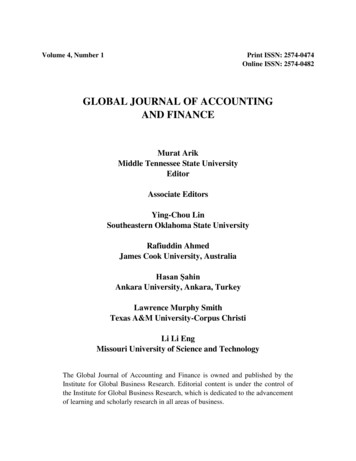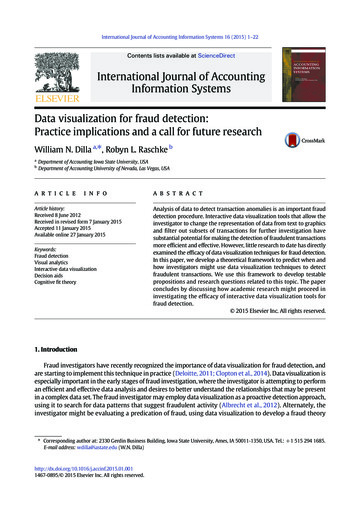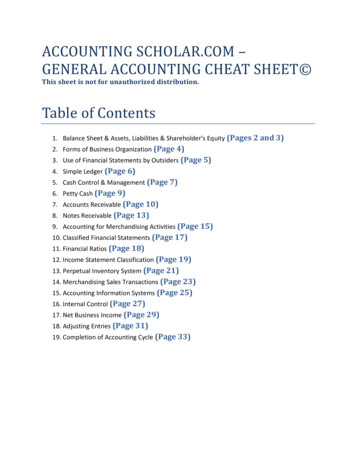
Transcription
Volume 4, Number 1Print ISSN: 2574-0474Online ISSN: 2574-0482GLOBAL JOURNAL OF ACCOUNTINGAND FINANCEMurat ArikMiddle Tennessee State UniversityEditorAssociate EditorsYing-Chou LinSoutheastern Oklahoma State UniversityRafiuddin AhmedJames Cook University, AustraliaHasan ŞahinAnkara University, Ankara, TurkeyLawrence Murphy SmithTexas A&M University-Corpus ChristiLi Li EngMissouri University of Science and TechnologyThe Global Journal of Accounting and Finance is owned and published by theInstitute for Global Business Research. Editorial content is under the control ofthe Institute for Global Business Research, which is dedicated to the advancementof learning and scholarly research in all areas of business.
Global Journal of Accounting and FinanceVolume 4, Number 1, 2020Authors execute a publication permission agreement and assume all liabilities.Institute for Global Business Research is not responsible for the content of theindividual manuscripts. Any omissions or errors are the sole responsibility of theauthors. The Editorial Board is responsible for the selection of manuscripts forpublication from among those submitted for consideration. The Publishers acceptfinal manuscripts in digital form and make adjustments solely for the purposes ofpagination and organization.The Global Journal of Accounting and Finance is owned and published by theInstitute for Global Business Research, 1 University Park Drive, Nashville, TN37204-3951 USA. Those interested in communicating with the Journal, shouldcontact the Executive Director of the Institute for Global Business Research atinfo@igbr.org.Copyright 2020 by Institute for Global Research, Nashville, TN, USA1
Global Journal of Accounting and FinanceVolume 4, Number 1, 2020EDITORIAL REVIEW BOARDA. VinodanCentral University of Tamil NaduMindy KushniroffWestern Governors UniversityAndrew PerumalUniversity of Massachusetts, BostonNabiyula GichiyevDagestan Scientific Center of the RussianAcademy of SciencesArthur L. Wharton, IIIVirginia State UniversityCheryl MitchemVirginia State UniversityDarryl J. WoolleyUniversity of IdahoDinesh Kumar SharmaGautam Buddha University, Greater NoidaElham FarzaneganNahavand University, IranFrank MichelloMiddle Tennessee State UniversityGianluca MattarocciUniversity of Rome Tor Vergata , RomeHafiz Imtiaz AhmadHigher Colleges of Technology, UAEHan-Sheng ChenLipscomb UniversityHema RaoSUNY-OswegoNeelam RaniIndian Institute of Management, ShillongNikhil Chandra ShilEast West University, DhakaOlga MatveievaDnipropetrovsk Regional Institute of PublicAdministration of the National Academy ofPublic Administration, UkrainePrasoom DwivediUniversity of Petroleum and Energy Studies,IndiaRobert D. CampbellHofstra UniversityRobert MarleyUniversity of TampaRon StundaValdosta State UniversitySagathevanSRM University, IndiaSean SalterMiddle Tennessee State University2
Global Journal of Accounting and FinanceHongxian ZhangeMissouri University of Science andTechnologyVolume 4, Number 1, 2020Shirley A. HunterUniversity of North Carolina CharlotteJames A. DiGabrieleMontclair State UniversitySorinel CăpuşneanuDimitrie Cantemir Christian University,BucharestJan L. WilliamsUniversity of BaltimoreStuart FowlerMiddle Tennessee State UniversityLinda BresslerSoutheastern Oklahoma State UniversitySurender KumarJaipuria Institute of Management, NoidaMalek LashgariUniversity of HartfordSusan ShurdenLander UniversityMarek GruszczynskiWarsaw School of Economics, PolandTheresa TiggemanUniversity of the Incarnate WordMichael GraysonCUNY–Brooklyn CollegeVasumathy HariharanSIR M Visvesvaraya Institute of ManagementStudies and Research, MumbaiXiaoquan JiangFlorida International University3
Global Journal of Accounting and FinanceVolume 4, Number 1, 2020TABLE OF CONTENTSDOES GOOD STEWARDSHIP REDUCE AGENCY COSTS IN THE IT SECTOR?EVIDENCE FROM DIVIDEND POLICY AND ESG RATINGS . 6Kevin M. Casey, Jr, University of Central Arkansas . 6K. Michael Casey, University of Central Arkansas . 6Ken Griffin, University of Central Arkansas . 6THE ACCEPTABILITY OF ONLINE DEGREES FOR OBTAINING ENTRY-LEVELEMPLOYMENT IN THE ACCOUNTING PROFESSION: A KANSAS STUDY . 16Cole J. Engel, Fort Hays State University . 16INVESTORS’ RISK PERCEPTION OF AUTOMOBILE ABS AFTER IMPLEMENTATIONOF MAJOR ACCOUNTING DISCLOSURE REQUIREMENTS . 37Arthur L. Wharton, III, Virginia State University . 37Hari Sharma, Virginia State University . 37Sonthe Nguyen, Caliber Home Loans, Irving TX . 37CURRENCY RETURNS AND LIQUIDITY PREMIUMS. EVIDENCE FROM HIGHERMOMENTS PORTFOLIO SORTING: VARIANCE, SKEWNESS, AND KURTOSIS . 49Phuvadon Wuthisatian, Hastings College . 49THE U.S. TAX CUTS AND JOBS ACT IN AN M&M CONTEXT: AN EXAMPLE . 73Thomas W. Secrest, Coastal Carolina University . 73Robert B. Burney, Coastal Carolina University. 73HOW DOMESTIC BUSINESSES DEDUCT BUSINESS INTEREST EXPENSES UNDERTHE NEW SECTION 163(J). 90Micah Frankel, California State University East Bay . 90John Tan, California State University East Bay . 90THE CURRENT STATE OF ETHICS EDUCATION IN ACCOUNTING PROGRAMS. 111Cara Robinson, Valdosta State University. 111Raymond J Elson, Valdosta State University . 111Jan L Williams, University of Baltimore . 111INVESTIGATION OF THE RELATIONSHIPS BETWEEN A PUBLIC COMPANY’SFINANCIAL FACTORS AND ITS STOCK PRICE: AN EMPIRICAL STUDY . 129Morsheda Hassan, Grambling State University . 129Raja Nassar, Louisisa Tech Universtiy . 129Aaron Witherspoon, Grambling State University . 1294
Global Journal of Accounting and FinanceVolume 4, Number 1, 2020STRATEGIC COST MANAGEMENT PRACTICES AND ORGANIZATIONALPERFORMANCE: A STUDY OF MANUFACTURING FIRMS IN NIGERIA . 142Ezekiel A. Adigbole, University of Ilorin, Nigeria . 142Arinola O. Adebayo, Virginia State University . 142Olubunmi F. Osemene, University of Ilorin, Nigeria . 142US COMMUNITY BANK PROFITABILITY: A CROSS-SECTIONAL AND DYNAMICPANEL ANALYSIS OF RURAL AND METROPOLITAN BANKS . 158Robert D. Morrison, University of Texas Permian Basin . 158Diego Escobari, University of Texas Rio Grande Valley . 1585
Global Journal of Accounting and FinanceVolume 4, Number 1, 2020DOES GOOD STEWARDSHIP REDUCE AGENCYCOSTS IN THE IT SECTOR? EVIDENCE FROMDIVIDEND POLICY AND ESG RATINGSKevin M. Casey, Jr, University of Central ArkansasK. Michael Casey, University of Central ArkansasKen Griffin, University of Central ArkansasABSTRACTThe link between corporate social responsibility, firm performance and variousdiscretionary managerial decisions is widely documented in the academic literature. Recently,ESG ratings emerged as one metric that quantifies components of social responsibility. ESG(environment, social and governance) ratings enable researchers to evaluate the firm’s overallsocial responsibility and then to parse that measure into its individual components to identifyspecific social responsibility decisions that may have greater impact on the firm. Recently,Yahoo! finance added a series of sustainability metrics that provide scores for a firm’s“environmental, social and governance issues” (ESG). The ESG data focuses on issues that aremost likely to affect the firm and assesses the firm’s “ability to mitigate ESG risks.” This studyobtained current 2019 data from Yahoo! finance for firms in the information technology (IT)sector. The sample size includes 50 firms with sufficient data to run the models. The positiverelationship between ESG rating and dividend yield suggests that firms with higher (better) ESGpercentile rankings have higher dividend yields. Overall, the results provide additional evidencethat firms consider several social and environmental factors when establishing dividend policy.INTRODUCTIONThe link between corporate social responsibility, firm performance and variousdiscretionary managerial decisions is widely documented in the academic literature. Galbreath(2010) shows a link between social responsibility and strategic orientation. Hsu (2018) showsthat firms that are better corporate stewards tend to make better financial decisions and do abetter job of allocating capital to positive net present value projects. Olowokudejo, Aduloju andOke (2011), in their study of Nigerian insurance companies, show that organizationaleffectiveness improves as firms become more socially responsible. Numerous other studies showsimilar linkages between social responsibilities and various measures of performance, includingBuallay (2019) and Feng, Wang and Kreuze (2017). Still other studies document a linkagebetween dividend payout and corporate social responsibility. Examples include Casey, Ellis,Casey (2019) and Samet and Jarboui (2017).Recently, ESG ratings emerged as one metric that quantifies components of socialresponsibility. ESG (environment, social and governance) ratings enable researchers to evaluatethe firm’s overall social responsibility and then to parse that measure into its individual6
Global Journal of Accounting and FinanceVolume 4, Number 1, 2020components to identify specific social responsibility decisions that may have greater impact onthe firm. Given that industry differences do exist, as shown by Feng et al. (2017) and Nyeadi,Ibrahim and Sare (2018), it is appropriate to study the impact of ESG ratings on firms in aspecific industry. In this paper we focus on the information technology (IT) sector given itsrecent prominence in the popular press with regard to privacy and data usage issues. We alsoevaluate the impact on dividend policy since dividend payout is often used as to mitigate agencyissues and push the firm to show greater transparency. The rest of this paper is organized asfollows. Section II contains a brief review of the relevant literature. Section III contains apresentation of the data and methodology, section IV presents the results, and Section V providessome concluding remarks and directions for future research.LITERATURE REVIEWJensen and Meckling’s (1976) paper on agency theory shows that problems emerge whenyou separate a firm’s ownership and management. These two disparate groups often havedifferent goals. For this reason, academics and practitioners alike have focused research effortson ways to align the goals of these two divergent groups. Costs incurred to align these goals areknown as agency costs. Various oversight and internal control techniques attempt to reduceagency costs by monitoring management to ensure management behavior is consistent with theprimary goal of the owners, which is shareholder wealth maximization.Dividend payment is one common technique firms use to reduce agency costs. Payingdividends depletes cash and forces the firm into the external capital markets to acquire necessaryfinancial capital for operations and/or expansion. Investor bankers, analysts, potential investorsand any external stakeholder evaluates the firm’s financial condition, recent managerial actions,corporate governance mechanisms, and other factors prior to providing external capital. Thisreview process uncovers any relevant external or internal issues that will negatively impact thefirm and future cash flows. Social responsibility issues fall into this category. Dividend paymentis therefore an agency cost since retaining dividends for internal financing would be an easieroption for firms seeking expansion capital or firms needing capital for existing operations. Giventhis relationship exists we can evaluate the linkage between dividend payment and socialresponsibility to determine whether firms that are more socially responsible pay more or less individends.Rozeff’s (1982) agency cost and transaction cost tradeoff model postulates that firmsadopt a dividend policy that minimizes their overall costs. When firms issue dividends and areforced to the external markets the firms incur issuance costs associated with raising new debt orequity. Firms must balance the costs of dividend payment and the cost of raising external capitalwith the value of the information disseminated in that process. The dividend payment mustconvey relevant information that reduces agency costs or the firm’s best decision would beretention of that cash dividend for other uses. Rozeff (1982) maintains that firms will adopt adividend payment policy that minimizes these overall costs. Easterbrook (1984) and Dempseyand Laber (1992) both support Rozeff’s model and an agency explanation of dividend payment.7
Global Journal of Accounting and FinanceVolume 4, Number 1, 2020Several studies, including Noronha, Shome, and Morgan (1996), use adaptations ofRozeff’s (1982) model. Moh’d, Perry, and Rimbey (1995) provide strong support for the modelover time and across various industries. Casey et al. (1999) extends Rozeff’s model to investigatethe relationship between payout policy and changes in the tax law. This study notes that industrydifferences exist with regard to payout policy. Other studies support industry differences.Dickens, Casey, and Newman (2002) study banking while Puleo, Smith, and Casey (2009) focuson the insurance industry. Both use variations of Rozeff’s (1982) model to evaluate dividenddecisions.The relationship between corporate governance and dividend payout is also documentedin the literature. For example, Puleo, Smith, and Casey (2009) find that regulated firms in theinsurance industry have a lessor need to pay dividends and subject the firm to the scrutiny of theexternal capital markets. Regulators appear to perform that function to the satisfaction of marketparticipants. In a separate study, Smith, Puleo, and Casey (2008) show that non-regulated firmswith higher corporate governance quotients also pay lower dividends. A higher corporategovernance quotient indicates the firm is a better steward and less likely to engage ininappropriate actions. It appears that firms recognized externally as better stewards can lowerdividend payout since they have a lessor need to convey governance information via dividendpayment and forcing firms into the external capital markets.Recently, Yahoo! finance added a series of sustainability metrics that provide scores for afirm’s “environmental, social and governance issues” (ESG). The ESG data focuses on issuesthat are most likely to affect the firm and assesses the firm’s “ability to mitigate ESG risks.”Casey, Casey and He (2018) use this data source and study the relationship between dividendpolicy and ESG factors in the utility industry. Their study did not find a relationship betweendividend policy and the ESG factors in the utility industry. However, the utility industry is highlyregulated, and regulation could reduce the need for firms to mitigate ESG risks. Other research,such as Casey, Smith and Puleo (2010), finds that firms in the oil and gas industry with strongercorporate governance structures paid lower dividends. This finding suggests that dividends doconvey information and dividend payment does subject the firm to greater external scrutiny.In this paper we focus on the relationship between dividend policy and ESG factors in anindustry that is often in the press for data stewardship and other social responsibility issues, theIT sector. We evaluate the impact on dividend yield using an overall ESG percentile score andthen look at the individual components of ESG. The ESG factor is split into governance,environmental and social affects with distinct numerical values. The addition of the controversyvariable provides even more detailed information about the public perception of the firm. Casey,Casey and He (2018) note that today’s investors are more interested in socially responsibleinvesting and are willing to reward firms that possess the desired socially responsiblecharacteristics and punish firms that do not possess these traits. For this reason, we expect to seea strong link between ESG ratings and dividend policy.8
Global Journal of Accounting and FinanceVolume 4, Number 1, 2020DATA AND METHODOLOGYThis study obtains current 2019 data from Yahoo! finance for firms in the informationtechnology (IT) sector. The data was collected in July of 2019. The sample size includes 50 firmswith sufficient data to run the models (Appendix A). We estimate the following version ofRozeff’s (1982) model consistent with Casey, Ellis and Casey (2019) and Casey, Smith andPuleo (2010) who both use a similar model in the oil and gas industry.DYj α BiXij Ɛ,Where:DY dividend yield as reported by Yahoo! financeXij represents each independent variable I, for each firm j. These variables are:INSTIT percentage of institutional ownership,BETA each firm’s beta,DEBT total debt/equity ratio,GROW next year’s percentage forecast growth rate in revenues,ESG Sustainalytics total ESG percentile rating,CONT controversy rating assigned by Sustainalytics.The ESG rating can be split into its three components of Environment rating (ENV),Social rating (SOC) and Governance rating (GOV). Each of these ESG ratings can fall between1-100. The ratings are calculated using a proprietary balanced scorecard system. Percentilerankings are also reported for these individual components. Justification for the includedvariables follows.CONT, or the controversy rating computed by Sustainalytics, assumes a value between 1 and 5and is assigned based on recent controversies involving the specific firm. A value of 5 isassigned to the most serious controversies that could negatively impact stakeholders, theenvironment, or the firm’s operations. Firms with higher controversy ratings will likely need toincrease dividend payout and subject the firm to the scrutiny of the financial markets with greaterfrequency.Justification for the other included control variables follows:Instit, defined as the percentage of institutional equity ownership, could have a positive ornegative relationship to dividend yield. Depending on the overall faith in management and fundgoals, institutional owners may desire to have dividends retained and invested or paid out toshareholders. Institutional ownership can exceed 100% in rare situations where one institutionborrows shares from another institution to short stock. If both institutions report the stock as“owned” then the percentage can exceed 100%.Beta, the firm’s beta computed and reported by Yahoo! finance, serves as a measur
Online ISSN: 2574-0482 GLOBAL JOURNAL OF ACCOUNTING AND FINANCE Murat Arik Middle Tennessee State University Editor Associate Editors Ying-Chou Lin Southeastern Oklahoma State University Rafiuddin Ahmed James Cook University, Australia Hasan Şahin Ankara University, Ankara, Turkey Lawrence Murph











